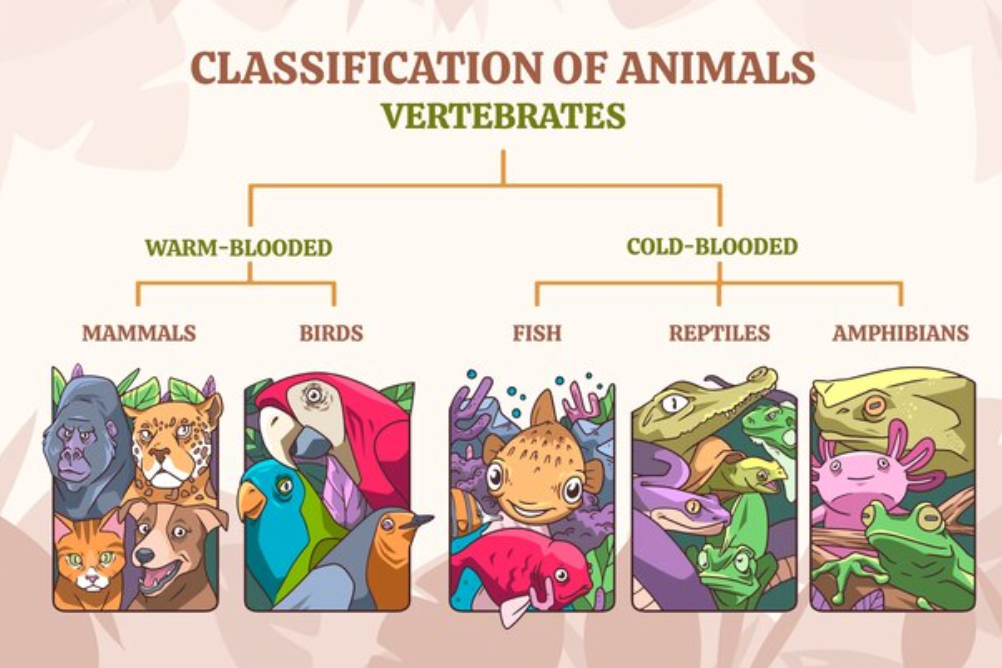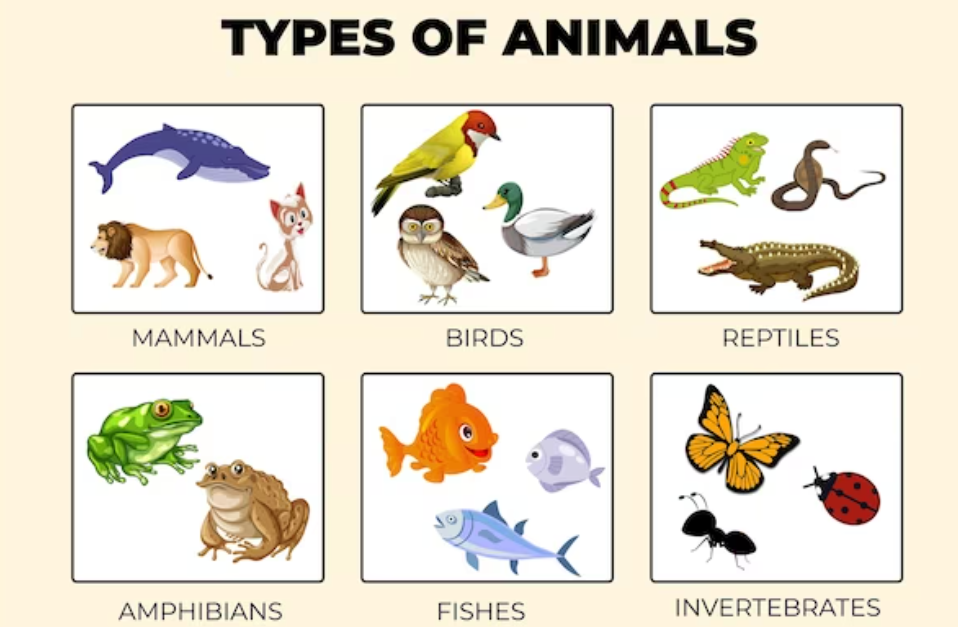Animal classification on the basis of adaptations, behavior, reproduction, and habitats
Animals and other creatures may be categorized according to a variety of attributes using different categorization schemes. They are often categorized according to their surroundings or habitat. For example, creatures classified as terrestrial include snakes, lions, and elephants and are mostly found on land. Conversely, aquatic animals—such as fish, dolphins, and whales—are suited to live in the water. A class of animals living in the sky that have evolved specific flying capabilities are called birds. Furthermore, certain species are adapted to live in harsh settings; examples of these are deep-sea organisms and extremophiles, which can withstand very high or low temperatures.
Animal classification on the basis of diet and food consumption
The food or eating habits of animals and creatures may also be used to categorize them. Herbivores, such as deer, cows, and rabbits, are creatures that eat mostly plants and vegetation. In contrast, predators known as carnivores—which include wolves, tigers, and lions—eat other animals. Omnivores—which include pigs, bears, and humans—consume a wider variety of foods, including both plants and animals. Certain species are especially specialized feeders; examples are nectarivores, which eat only the nectar of flowers, and insectivores, who eat exclusively insects.
Animal classification on the basis of body structure and composition
Classification of creatures and animals may also be done on the basis of their bodily composition and adaptations. Vertebrates, which include fish, amphibians, birds, reptiles, and mammals, are creatures that have a backbone. Invertebrates, on the other hand, are animals without backbones that include worms, mollusks, spiders, and insects. Furthermore, animals may be categorized according to how they reproduce. For example, birds and reptiles are oviparous animals, meaning they lay eggs, while mammals are viviparous, meaning they give birth to live offspring. In addition, organisms may be classified according to their evolutionary connections, whereby distinct species are grouped together on the basis of their common ancestry and genetic similarities.

Animal classification and the different categories or groups of animals
The varied array of living things that call our planet home are called animals. They have distinct qualities and come in a variety of sizes and forms. This essay will examine many animal species and their intriguing characteristics.
1. Mammals
Warm-blooded creatures with hair or fur that produce milk to feed their young are called mammals. They are recognized for their capacity to control their body temperature and give birth to live young. A vast variety of creatures, including dogs, cats, elephants, and humans, are classified as mammals.
2. Birds
Animals classified as vertebrates, such as birds, have beaks, feathers, and hard-shelled eggs. Though some animals are flightless, they can still fly. Birds range in size, from enormous ostriches to small hummingbirds. Their vivid plumage and lovely melodies are well-known attributes.
3. Reptiles
Reptiles lay eggs on animals with scaly skin and cold blood. They include animals like crocodiles, turtles, lizards, and snakes. Reptiles may be found on land, in the water, or even in the air since they are well suited to a variety of habitats.
4. Amphibians
Animals with cold blood that transform from an aquatic larval stage to an adult terrestrial stage are known as amphibians. They deposit their eggs in water and have wet skin. Amphibians include creatures like salamanders, frogs, and toads. Their capacity to survive in both water and on land is well recognized.
5. Fish
Fish are aquatic creatures with fins and gills. They get their oxygen from the water in which they dwell. Fish range in size and form, from little tropical fish to enormous sharks. Both freshwater and saltwater habitats support them.
6. Invertebrates
Invertebrates are classified as non-vertebrate creatures. On Earth, they comprise the vast majority of animal species. Invertebrates include mollusks, crabs, worms, spiders, and insects. They are present in almost every ecosystem on earth and have a diverse spectrum of adaptations.
7. Arthropods
Invertebrates with jointed legs and a hard exoskeleton are known as arthropods. They consist of millipedes, spiders, insects, and crustaceans. With more than a million species identified, arthropods are the most varied group of creatures on Earth.
8. Echinoderms
Marine creatures with radial symmetry and spiky skin are called echinoderms. Sea cucumbers, sea urchins, and starfish are echinoderm examples. They are ubiquitous in seas worldwide and are crucial components of marine ecosystems.
9. Mollusks
Soft-bodied creatures with rigid shells for protection are known as mollusks. Squids, clams, octopuses, and snails are among them. Mollusks have a diverse variety of feeding and movement strategies and may be found in both aquatic and terrestrial habitats.
10. Protozoa
Single-celled creatures known as protozoa are present in a variety of settings, such as dirt, water, and other living things’ bodies. They have a variety of shapes and purposes, and they are tiny. Protozoa serve as food for other creatures and have significant functions in the cycling of nutrients.

11. Corals
A hard calcium-carbonate skeleton is secreted by corals, which are marine invertebrates. They are a vital component of coral reef ecosystems and come in a range of sizes and forms.
12. Cnidarians
These multicellular, soft-bodied creatures contain stinging cells in their tentacles. Corals, anemones, and jellyfish are a few of the species in this category.
13. Sponges
Unlike the species covered previously, sponges are far more basic and are distinguished by their porous, hollow bodies. They eat bacteria and other microbes they pick up from the water, but they don’t have stomachs.
These are just a few of the many varieties of animals that inhabit our planet. Every kind of animal has distinct qualities and adaptations that enable them to flourish in their particular habitats. We can better appreciate the intricacy and beauty of the natural world when we are aware of the variety of species.
